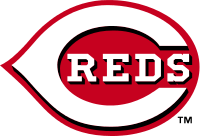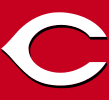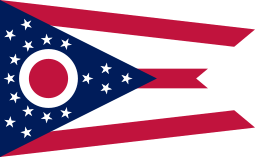Cincinnati Reds
The Cincinnati Reds are an American professional baseball team based in Cincinnati, Ohio. They compete in Major League Baseball (MLB) as a member club of the National League (NL) Central division. They were a charter member of the American Association in 1882 and joined the NL in 1890.[3]
| Cincinnati Reds | |||||
|---|---|---|---|---|---|
| Established in 1881 | |||||
| |||||
| Major league affiliations | |||||
| |||||
| Current uniform | |||||
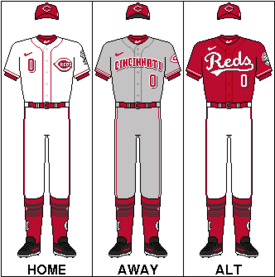 | |||||
| Retired numbers | |||||
| Colors | |||||
| Name | |||||
| Other nicknames | |||||
| Ballpark | |||||
| |||||
| Major league titles | |||||
| World Series titles (5) | |||||
| NL Pennants (9) | |||||
| AA Pennants (1) | 1882 | ||||
| NL Central Division titles (3) | |||||
| NL West Division titles (7) | |||||
| Wild card berths (1) | 2013 | ||||
| Front office | |||||
| Principal owner(s) | Bob Castellini | ||||
| Manager | David Bell | ||||
| General manager | Nick Krall | ||||
| President of baseball operations | Dick Williams | ||||
The Reds played in the NL West division from 1969 to 1993, before joining the Central division in 1994. They have won five World Series championships, nine NL pennants, one AA pennant, and 10 division titles. The team plays its home games at Great American Ball Park, which opened in 2003 replacing Riverfront Stadium. Bob Castellini has been chief executive officer since 2006.
From 1882 to 2019, the Reds' overall win-loss record is 10,599–10,393 (a .505 winning percentage).[4]
Franchise history
The birth of the Reds and the American Association (1881–1889)
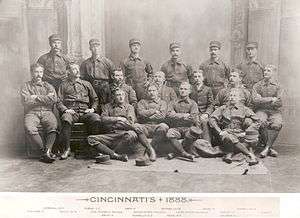
The origins of the modern Cincinnati Reds can be traced to the expulsion of an earlier team bearing that name. In 1876, Cincinnati became one of the charter members of the new National League, but the club ran afoul of league organizer and long-time president William Hulbert for selling beer during games and renting out their ballpark on Sundays. Both were important activities to entice the city's large German population. While Hulbert made clear his distaste for both beer and Sunday baseball at the founding of the league, neither practice was actually against league rules in those early years. On October 6, 1880, however, seven of the eight team owners pledged at a special league meeting to formally ban both beer and Sunday baseball at the regular league meeting that December. Only Cincinnati president W. H. Kennett refused to sign the pledge, so the other owners formally expelled Cincinnati for violating a rule that would not actually go into effect for two more months.
Cincinnati's expulsion from the National League incensed Cincinnati Enquirer sports editor O. P. Caylor, who made two attempts to form a new league on behalf of the receivers for the now bankrupt Reds franchise. When these attempts failed, he formed a new independent ballclub known as the Red Stockings in the Spring of 1881, and brought the team to St. Louis for a weekend exhibition. The Reds' first game was a 12–3 victory over the St. Louis club. After the 1881 series proved a success, Caylor and a former president of the old Reds named Justus Thorner received an invitation from Philadelphia businessman Horace Phillips to attend a meeting of several clubs in Pittsburgh with the intent of establishing a rival to the National League. Upon arriving in the city, however, Caylor and Thorner discovered that no other owners had decided to accept the invitation, with even Phillips not bothering to attend his own meeting. By chance, the duo met a former pitcher named Al Pratt, who hooked them up with former Pittsburgh Alleghenys president H. Denny McKnight. Together, the three men hatched a scheme to form a new league by sending a telegram to each of the other owners who were supposed to attend the meeting stating that he was the only person who did not attend and that everyone else was enthusiastic about the new venture and eager to attend a second meeting in Cincinnati. The ploy worked, and the American Association was officially formed at the Hotel Gibson in Cincinnati with the new Reds a charter member with Thorner as president.
Led by the hitting of third baseman Hick Carpenter, the defense of future Hall of Fame second baseman Bid McPhee, and the pitching of 40-game-winner Will White, the Reds won the inaugural AA pennant in 1882. With the establishment of the Union Association Justus Thorner left the club to finance the Cincinnati Outlaw Reds and managed to acquire the lease on the Reds Bank Street Grounds playing field, forcing new president Aaron Stern to relocate three blocks away at the hastily built League Park. The club never placed higher than second or lower than fifth for the rest of its tenure in the American Association.
The National League returns to Cincinnati (1890–1911)
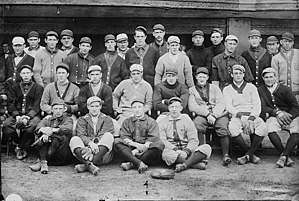
The Cincinnati Red Stockings left the American Association on November 14, 1889 and joined the National League along with the Brooklyn Bridegrooms after a dispute with St. Louis Browns owner Chris Von Der Ahe over the selection of a new league president. The National League was happy to accept the teams in part due to the emergence of the new Player's League. This new league, an early failed attempt to break the reserve clause in baseball, threatened both existing leagues. Because the National League decided to expand while the American Association was weakening, the team accepted an invitation to join the National League. It was also at this time that the team first shortened their name from "Red Stockings" to "Reds". The Reds wandered through the 1890s signing local stars and aging veterans. During this time, the team never finished above third place (1897) and never closer than 101⁄2 games (1890).
At the start of the 20th century, the Reds had hitting stars Sam Crawford and Cy Seymour. Seymour's .377 average in 1905 was the first individual batting crown won by a Red. In 1911, Bob Bescher stole 81 bases, which is still a team record. Like the previous decade, the 1900s (decade) were not kind to the Reds, as much of the decade was spent in the league's second division.
Redland Field to the Great Depression (1912–1932)
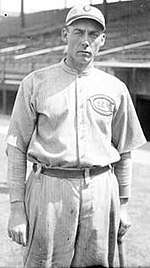
In 1912, the club opened a new steel-and-concrete ballpark, Redland Field (later to be known as Crosley Field). The Reds had been playing baseball on that same site, the corner of Findlay and Western Avenues on the city's west side, for 28 years, in wooden structures that had been occasionally damaged by fires. By the late 1910s the Reds began to come out of the second division. The 1918 team finished fourth, and new manager Pat Moran led the Reds to an NL pennant in 1919, in what the club advertised as its "Golden Anniversary". The 1919 team had hitting stars Edd Roush and Heinie Groh while the pitching staff was led by Hod Eller and left-hander Harry "Slim" Sallee. The Reds finished ahead of John McGraw's New York Giants, and then won the world championship in eight games over the Chicago White Sox.
By 1920, the "Black Sox" scandal had brought a taint to the Reds' first championship. After 1926, and well into the 1930s, the Reds were second division dwellers. Eppa Rixey, Dolf Luque and Pete Donohue were pitching stars, but the offense never lived up to the pitching. By 1931, the team was bankrupt, the Great Depression was in full swing and Redland Field was in a state of disrepair.
Championship baseball and revival (1933–1940)
Powel Crosley, Jr., an electronics magnate who, with his brother Lewis M. Crosley, produced radios, refrigerators, and other household items, bought the Reds out of bankruptcy in 1933, and hired Larry MacPhail to be the General Manager. Crosley had started WLW radio, the Reds flagship radio broadcaster, and the Crosley Broadcasting Corporation in Cincinnati, where he was also a prominent civic leader. MacPhail began to develop the Reds' minor league system and expanded the Reds' fan base. The Reds, throughout the 1930s, became a team of "firsts". The now-renamed Crosley Field became the host of the first night game in 1935, which was also the first baseball fireworks night, the fireworks at the game were shot by Joe Rozzi of Rozzi's Famous Fireworks. Johnny Vander Meer became the only pitcher in major league history to throw back-to-back no-hitters in 1938. Thanks to Vander Meer, Paul Derringer and second baseman/third baseman-turned-pitcher Bucky Walters, the Reds had a solid pitching staff. The offense came around in the late 1930s. By 1938 the Reds, now led by manager Bill McKechnie, were out of the second division finishing fourth. Ernie Lombardi was named the National League's Most Valuable Player in 1938. By 1939, they were National League champions, but in the World Series, they were swept by the New York Yankees. In 1940, they repeated as NL Champions, and for the first time in 21 years, the Reds captured a World championship, beating the Detroit Tigers 4 games to 3. Frank McCormick was the 1940 NL MVP. Other position players included Harry Craft, Lonny Frey, Ival Goodman, Lew Riggs and Bill Werber.
1941–1969
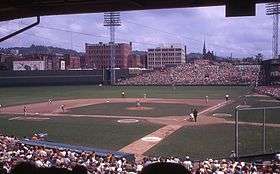
World War II and age finally caught up with the Reds. Throughout the 1940s and early 1950s, Cincinnati finished mostly in the second division. In 1944, Joe Nuxhall (who was later to become part of the radio broadcasting team), at age 15, pitched for the Reds on loan from Wilson Junior High school in Hamilton, Ohio. He became the youngest player ever to appear in a major league game—a record that still stands today. Ewell "The Whip" Blackwell was the main pitching stalwart before arm problems cut short his career. Ted Kluszewski was the NL home run leader in 1954. The rest of the offense was a collection of over-the-hill players and not-ready-for-prime-time youngsters.
In April 1953, the Reds announced a preference to be called the "Redlegs", saying that the name of the club had been "Red Stockings" and then "Redlegs". A newspaper speculated that it was due to the developing political connotation of the word 'red' to mean Communism.[5] From 1956 to 1960, the club's logo was altered to remove the term "REDS" from the inside of the "wishbone C" symbol. The "REDS" reappeared on the 1961 uniforms, but the point of the C was removed, leaving a smooth, non-wishbone curve. The traditional home-uniform logo was restored in 1967.
In 1956, led by National League Rookie of the Year Frank Robinson, the Redlegs hit 221 HR to tie the NL record. By 1961, Robinson was joined by Vada Pinson, Wally Post, Gordy Coleman, and Gene Freese. Pitchers Joey Jay, Jim O'Toole, and Bob Purkey led the staff.
The Reds captured the 1961 National League pennant, holding off the Los Angeles Dodgers and the San Francisco Giants, only to be defeated by the perennially powerful New York Yankees in the World Series.
The Reds had winning teams during the rest of the 1960s, but did not produce any championships. They won 98 games in 1962, paced by Purkey's 23, but finished third. In 1964, they lost the pennant by one game to the Cardinals after having taken first place when the Phillies collapsed in September. Their beloved manager Fred Hutchinson died of cancer just weeks after the end of the 1964 season. The failure of the Reds to win the 1964 pennant led to owner Bill DeWitt's selling off key components of the team, in anticipation of relocating the franchise. In response to DeWitt's threatened move, the women of Cincinnati banded together to form the Rosie Reds to urge DeWitt to keep the franchise in Cincinnati. The Rosie Reds are still in existence, and are currently the oldest fan club in Major League Baseball. After the 1965 season he executed what may be the most lopsided trade in baseball history, sending former Most Valuable Player Frank Robinson to the Baltimore Orioles for pitchers Milt Pappas and Jack Baldschun, and outfielder Dick Simpson. Robinson went on to win the MVP and triple crown in the American league for 1966, and lead Baltimore to its first ever World Series title in a sweep of the Los Angeles Dodgers. The Reds did not recover from this trade until the rise of the "Big Red Machine" of the 1970s.
Starting in the early 1960s, the Reds' farm system began producing a series of stars, including Jim Maloney (the Reds' pitching ace of the 1960s), Pete Rose, Tony Pérez, Johnny Bench, Lee May, Tommy Helms, Bernie Carbo, Hal McRae, Dave Concepción, and Gary Nolan. The tipping point came in 1967 with the appointment of Bob Howsam as general manager. That same year the Reds avoided a move to San Diego when the city of Cincinnati and Hamilton County agreed to build a state of the art, downtown stadium on the edge of the Ohio River. The Reds entered into a 30-year lease in exchange for the stadium commitment keeping the franchise in its original home city. In a series of strategic moves, Howsam brought in key personnel to complement the homegrown talent. The Reds' final game at Crosley Field, home to more than 4,500 baseball games, was played on June 24, 1970, a 5–4 victory over the San Francisco Giants.
Under Howsam's administration starting in the late 1960s, the Reds instituted a strict rule barring the team's players from wearing facial hair and long hair. The clean cut look was meant to present the team as wholesome in an era of turmoil. All players coming to the Reds were required to shave and cut their hair for the next three decades. Over the years, the rule was controversial, but persisted well into the ownership of Marge Schott. On at least one occasion, in the early 1980s, enforcement of this rule lost them the services of star reliever and Ohio native Rollie Fingers, who would not shave his trademark handlebar mustache in order to join the team.[6] The rule was not officially rescinded until 1999 when the Reds traded for slugger Greg Vaughn, who had a goatee. The New York Yankees continue to have a similar rule today, though unlike the Reds during this period, Yankees players are permitted to have mustaches. Much like when players leave the Yankees today, players who left the Reds took advantage with their new teams; Pete Rose, for instance, grew his hair out much longer than would be allowed by the Reds once he signed with the Philadelphia Phillies in 1979.
The Reds' rules also included conservative uniforms. In Major League Baseball, a club generally provides most of the equipment and clothing needed for play. However, players are required to supply their gloves and shoes themselves. Many players enter into sponsorship arrangements with shoe manufacturers, but through the mid-1980s, the Reds had a strict rule that players were to wear only plain black shoes with no prominent logo. Reds players decried what they considered to be the boring color choice as well as the denial of the opportunity to earn more money through shoe contracts. A compromise was struck in 1985 in which players could paint red marks on their black shoes, then the following year, they were allowed to wear all-red shoes.[7]
The Big Red Machine (1970–1976)
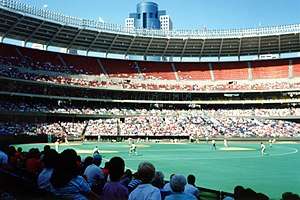
In 1970, little known George "Sparky" Anderson was hired as manager, and the Reds embarked upon a decade of excellence, with a team that came to be known as "The Big Red Machine". Playing at Crosley Field until June 30, 1970, when the Reds moved into brand-new Riverfront Stadium, a 52,000 seat multi-purpose venue on the shores of the Ohio River, the Reds began the 1970s with a bang by winning 70 of their first 100 games. Johnny Bench, Tony Pérez, Pete Rose, Lee May and Bobby Tolan were the early Red Machine offensive leaders; Gary Nolan, Jim Merritt, Wayne Simpson and Jim McGlothlin led a pitching staff which also contained veterans Tony Cloninger and Clay Carroll and youngsters Pedro Borbón and Don Gullett. The Reds breezed through the 1970 season, winning the NL West and captured the NL pennant by sweeping the Pittsburgh Pirates in three games. By the time the club got to the World Series, however, the Reds pitching staff had run out of gas and the veteran Baltimore Orioles, led by Hall of Fame third baseman and World Series MVP Brooks Robinson, beat the Reds in five games.
After the disastrous 1971 season (the only season of the 1970s during which the Reds finished with a losing record) the Reds reloaded by trading veterans Jimmy Stewart, May, and Tommy Helms for Joe Morgan, César Gerónimo, Jack Billingham, Ed Armbrister, and Denis Menke. Meanwhile, Dave Concepción blossomed at shortstop. 1971 was also the year a key component of the future world championships was acquired in George Foster from the San Francisco Giants in a trade for shortstop Frank Duffy.
The 1972 Reds won the NL West in baseball's first ever strike-shortened season and defeated the Pittsburgh Pirates in an exciting five-game playoff series. They then faced the Oakland Athletics in the World Series. Six of the seven games were won by one run. With powerful slugger Reggie Jackson sidelined by an injury incurred during Oakland's playoff series, Ohio native Gene Tenace got a chance to play in the series, delivering four home runs that tied the World Series record for homers, propelling Oakland to a dramatic seven-game series win. This was one of the few World Series in which no starting pitcher for either side pitched a complete game.
The Reds won a third NL West crown in 1973 after a dramatic second half comeback, that saw them make up 10 1⁄2 games on the Los Angeles Dodgers after the All-Star break. However they lost the NL pennant to the New York Mets in five games in the NLCS. In game one, Tom Seaver faced Jack Billingham in a classic pitching duel, with all three runs of the 2–1 margin being scored on home runs. John Milner provided New York's run off Billingham, while Pete Rose tied the game in the seventh inning off Seaver, setting the stage for a dramatic game ending home run by Johnny Bench in the bottom of the ninth. The New York series provided plenty of controversy with the riotous behavior of Shea Stadium fans towards Pete Rose when he and Bud Harrelson scuffled after a hard slide by Rose into Harrelson at second base during the fifth inning of Game 3. A full bench-clearing fight resulted after Harrelson responded to Rose's aggressive move to prevent him from completing a double play by calling him a name. This also led to two more incidents in which play was stopped. The Reds trailed 9–3 and New York's manager, Yogi Berra, and legendary outfielder Willie Mays, at the request of National League president Warren Giles, appealed to fans in left field to restrain themselves. The next day the series was extended to a fifth game when Rose homered in the 12th inning to tie the series at two games each.
The Reds won 98 games in 1974 but they finished second to the 102-win Los Angeles Dodgers. The 1974 season started off with much excitement, as the Atlanta Braves were in town to open the season with the Reds. Hank Aaron entered opening day with 713 home runs, one shy of tying Babe Ruth's record of 714. The first pitch Aaron swung at in the 1974 season was the record tying home run off Jack Billingham. The next day the Braves benched Aaron, hoping to save him for his record-breaking home run on their season-opening homestand. The commissioner of baseball, Bowie Kuhn, ordered Braves management to play Aaron the next day, where he narrowly missed the historic home run in the fifth inning. Aaron went on to set the record in Atlanta two nights later. The 1974 season was also the debut of Hall of Fame radio announcer Marty Brennaman, who replaced Al Michaels, after Michaels left the Reds to broadcast for the San Francisco Giants.
With 1975, the Big Red Machine lineup solidified with the "Great Eight"[8][9] starting team of Johnny Bench (catcher), Tony Pérez (first base), Joe Morgan (second base), Dave Concepción (shortstop), Pete Rose (third base), Ken Griffey (right field), César Gerónimo (center field), and George Foster (left field). The starting pitchers included Don Gullett, Fred Norman, Gary Nolan, Jack Billingham, Pat Darcy, and Clay Kirby. The bullpen featured Rawly Eastwick and Will McEnaney combining for 37 saves, and veterans Pedro Borbón and Clay Carroll. On Opening Day, Rose still played in left field, Foster was not a starter, while John Vukovich, an off-season acquisition, was the starting third baseman. While Vuckovich was a superb fielder, he was a weak hitter. In May, with the team off to a slow start and trailing the Dodgers, Sparky Anderson made a bold move by moving Rose to third base, a position where he had very little experience, and inserting Foster in left field. This was the jolt that the Reds needed to propel them into first place, with Rose proving to be reliable on defense, while adding Foster to the outfield gave the offense some added punch. During the season, the Reds compiled two notable streaks: (1) by winning 41 out of 50 games in one stretch, and (2) by going a month without committing any errors on defense.
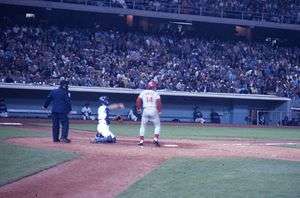
In the 1975 season, Cincinnati clinched the NL West with 108 victories, then swept the Pittsburgh Pirates in three games to win the NL pennant. In the World Series, the Boston Red Sox were the opponents. After splitting the first four games, the Reds took Game 5. After a three-day rain delay, the two teams met in Game 6, one of the most memorable baseball games ever played and considered by many to be the best World Series game ever. The Reds were ahead 6–3 with 5 outs left, when the Red Sox tied the game on former Red Bernie Carbo's three-run home run. It was Carbo's second pinch-hit three-run homer in the series. After a few close-calls either way, Carlton Fisk hit a dramatic 12th inning home run off the foul pole in left field to give the Red Sox a 7–6 win and force a deciding Game 7. Cincinnati prevailed the next day when Morgan's RBI single won Game 7 and gave the Reds their first championship in 35 years. The Reds have not lost a World Series game since Carlton Fisk's home run, a span of 9 straight wins.
1976 saw a return of the same starting eight in the field. The starting rotation was again led by Nolan, Gullett, Billingham, and Norman, while the addition of rookies Pat Zachry and Santo Alcalá comprised an underrated staff in which four of the six had ERAs below 3.10. Eastwick, Borbon, and McEnaney shared closer duties, recording 26, 8, and 7 saves respectively. The Reds won the NL West by ten games. They went undefeated in the postseason, sweeping the Philadelphia Phillies (winning Game 3 in their final at-bat) to return to the World Series. They continued to dominate by sweeping the Yankees in the newly renovated Yankee Stadium, the first World Series games played in Yankee Stadium since 1964. This was only the second ever sweep of the Yankees in the World Series. In winning the Series, the Reds became the first NL team since the 1921–22 New York Giants to win consecutive World Series championships, and the Big Red Machine of 1975–76 is considered one of the best teams ever. So far in MLB history, the 1975 and '76 Reds were the last NL team to repeat as champions.
Beginning with the 1970 National League pennant, the Reds beat either of the two Pennsylvania-based clubs, the Philadelphia Phillies or the Pittsburgh Pirates to win their pennants (Pirates in 1970, 1972, 1975, and 1990, Phillies in 1976), making The Big Red Machine part of the rivalry between the two Pennsylvania teams. In 1979, Pete Rose added further fuel in The Big Red Machine being part of the rivalry when he signed with the Phillies and helped them win their first World Series championship in 1980.
The Machine dismantled (1977–1989)
The later years of the 1970s brought turmoil and change. Popular Tony Pérez was sent to Montreal after the 1976 season, breaking up the Big Red Machine's starting lineup. Manager Sparky Anderson and General Manager Bob Howsam later considered this trade the biggest mistake of their careers. Starting pitcher Don Gullett left via free agency and signed with the New York Yankees. In an effort to fill that gap, a trade with the Oakland A's for starting ace Vida Blue was arranged during the 1976–77 off-season. However, Bowie Kuhn, the Commissioner of Baseball, vetoed the trade for the stated reason of maintaining competitive balance in baseball. Some have suggested that the actual reason had more to due with Kuhn's continued feud with Oakland A's owner Charlie Finley. On June 15, 1977, the Reds acquired Mets' franchise pitcher Tom Seaver for Pat Zachry, Doug Flynn, Steve Henderson, and Dan Norman. In other deals that proved to be less successful, the Reds traded Gary Nolan to the Angels for Craig Hendrickson, Rawly Eastwick to St. Louis for Doug Capilla and Mike Caldwell to Milwaukee for Rick O'Keeffe and Garry Pyka, and got Rick Auerbach from Texas. The end of the Big Red Machine era was heralded by the replacement of General Manager Bob Howsam with Dick Wagner.
In Rose's last season as a Red, he gave baseball a thrill as he challenged Joe DiMaggio's 56-game hitting streak, tying for the second-longest streak ever at 44 games. The streak came to an end in Atlanta after striking out in his fifth at bat in the game against Gene Garber. Rose also earned his 3,000th hit that season, on his way to becoming baseball's all-time hits leader when he rejoined the Reds in the mid-1980s. The year also witnessed the only no-hitter of Hall of Fame pitcher Tom Seaver's career, coming against the St. Louis Cardinals on June 16, 1978.
After the 1978 season and two straight second-place finishes, Wagner fired manager Anderson—an unpopular move. Pete Rose, who since 1963 had played almost every position for the team except pitcher, shortstop, and catcher, signed with Philadelphia as a free agent. By 1979, the starters were Bench (c), Dan Driessen (1b), Morgan (2b), Concepción (ss), Ray Knight (3b), with Griffey, Foster, and Geronimo again in the outfield. The pitching staff had experienced a complete turnover since 1976 except for Fred Norman. In addition to ace starter Tom Seaver; the remaining starters were Mike LaCoss, Bill Bonham, and Paul Moskau. In the bullpen, only Borbon had remained. Dave Tomlin and Mario Soto worked middle relief with Tom Hume and Doug Bair closing. The Reds won the 1979 NL West behind the pitching of Tom Seaver but were dispatched in the NL playoffs by Pittsburgh. Game 2 featured a controversial play in which a ball hit by Pittsburgh's Phil Garner was caught by Cincinnati outfielder Dave Collins but was ruled a trap, setting the Pirates up to take a 2–1 lead. The Pirates swept the series 3 games to 0 and went on to win the World Series against the Baltimore Orioles.
The 1981 team fielded a strong lineup, but with only Concepción, Foster, and Griffey retaining their spots from the 1975–76 heyday.[10][11] After Johnny Bench was able to play only a few games at catcher each year after 1980 due to ongoing injuries, Joe Nolan took over as starting catcher. Driessen and Bench shared 1st base, and Knight starred at third. Morgan and Geronimo had been replaced at second base and center field by Ron Oester and Dave Collins. Mario Soto posted a banner year starting on the mound, only surpassed by the outstanding performance of Seaver's Cy Young runner-up season. La Coss, Bruce Berenyi, and Frank Pastore rounded out the starting rotation. Hume again led the bullpen as closer, joined by Bair and Joe Price. In 1981, Cincinnati had the best overall record in baseball, but they finished second in the division in both of the half-seasons that were created after a mid-season players' strike, and missed the playoffs. To commemorate this, a team photo was taken, accompanied by a banner that read "Baseball's Best Record 1981".
By 1982, the Reds were a shell of the original Red Machine; they lost 101 games that year.[12] Johnny Bench, after an unsuccessful transition to 3rd base, retired a year later.
After the heartbreak of 1981, General Manager Dick Wagner pursued the strategy of ridding the team of veterans including third-baseman Knight and the entire starting outfield of Griffey, Foster, and Collins. Bench, after being able to catch only seven games in 1981, was moved from platooning at first base to be the starting third baseman; Alex Treviño became the regular starting catcher. The outfield was staffed with Paul Householder, César Cedeño, and future Colorado Rockies & Pittsburgh Pirates manager Clint Hurdle on opening day. Hurdle was an immediate bust, and rookie Eddie Milner took his place in the starting outfield early in the year. The highly touted Householder struggled throughout the year despite extensive playing time. Cedeno, while providing steady veteran play, was a disappointment, and was unable to recapture his glory days with the Houston Astros. The starting rotation featured the emergence of a dominant Mario Soto, and featured strong years by Pastore and Bruce Berenyi, but Seaver was injured all year, and their efforts were wasted without a strong offensive lineup. Tom Hume still led the bullpen, along with Joe Price. But the colorful Brad "The Animal" Lesley was unable to consistently excel, and former all-star Jim Kern was a big disappointment. Kern was also publicly upset over having to shave off his prominent beard to join the Reds, and helped force the issue of getting traded during mid-season by growing it back. The season also saw the midseason firing of Manager John McNamara, who was replaced as skipper by Russ Nixon.
The Reds fell to the bottom of the Western Division for the next few years. After the 1982 season, Seaver was traded back to the Mets. The year 1983 found Dann Bilardello behind the plate, Bench returning to part-time duty at first base, rookies Nick Esasky taking over at third base and Gary Redus taking over from Cedeno. Tom Hume's effectiveness as a closer had diminished, and no other consistent relievers emerged. Dave Concepción was the sole remaining starter from the Big Red Machine era.
Wagner's tenure ended in 1983, when Howsam, the architect of the Big Red Machine, was brought back. The popular Howsam began his second term as Reds' General Manager by signing Cincinnati native Dave Parker as a free agent from Pittsburgh. In 1984 the Reds began to move up, depending on trades and some minor leaguers. In that season Dave Parker, Dave Concepción and Tony Pérez were in Cincinnati uniforms. In August 1984, Pete Rose was reacquired and hired to be the Reds player-manager. After raising the franchise from the grave, Howsam gave way to the administration of Bill Bergesch, who attempted to build the team around a core of highly regarded young players in addition to veterans like Parker. However, he was unable to capitalize on an excess of young and highly touted position players including Kurt Stillwell, Tracy Jones, and Kal Daniels by trading them for pitching. Despite the emergence of Tom Browning as rookie of the year in 1985 when he won 20 games, the rotation was devastated by the early demise of Mario Soto's career to arm injury.
Under Bergesch, from 1985–89 the Reds finished second four times. Among the highlights, Rose became the all-time hits leader, Tom Browning threw a perfect game, Eric Davis became the first player in baseball history to hit at least 35 home runs and steal 50 bases, and Chris Sabo was the 1988 National League Rookie of the Year. The Reds also had a bullpen star in John Franco, who was with the team from 1984 to 1989. Rose once had Concepción pitch late in a game at Dodger Stadium. Following the release of the Dowd Report which accused Rose for betting on baseball games, in 1989 Rose was banned from baseball by Commissioner Bart Giamatti, who declared Rose guilty of "conduct detrimental to baseball". Controversy also swirled around Reds owner Marge Schott, who was accused several times of ethnic and racial slurs.[13]
World Championship and the end of an era (1990–2002)
In 1987, General Manager Bergesch was replaced by Murray Cook, who initiated a series of deals that would finally bring the Reds back to the championship, starting with acquisitions of Danny Jackson and José Rijo. An aging Dave Parker was let go after a revival of his career in Cincinnati following the Pittsburgh drug trials. Barry Larkin emerged as the starting shortstop over Kurt Stillwell, who along with reliever Power, was traded for Jackson. In 1989, Cook was succeeded by Bob Quinn, who put the final pieces of the championship puzzle together, with the acquisitions of Hal Morris, Billy Hatcher and Randy Myers.
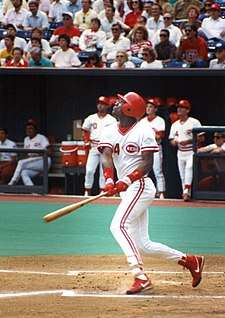
In 1990, the Reds under new manager Lou Piniella shocked baseball by leading the NL West from wire-to-wire. Winning their first nine games, they started off 33–12 and maintained their lead throughout the year. Led by Chris Sabo, Barry Larkin, Eric Davis, Paul O'Neill and Billy Hatcher in the field, and by José Rijo, Tom Browning and the "Nasty Boys" of Rob Dibble, Norm Charlton and Randy Myers on the mound, the Reds took out the Pirates in the NLCS. The Reds swept the heavily favored Oakland Athletics in four straight, and extended a Reds winning streak in the World Series to nine consecutive games. The World Series, however, saw Eric Davis severely bruise a kidney diving for a fly ball in Game 4, and his play was greatly limited the next year. In winning the World Series the Reds became the only National League team to go wire to wire.
In 1992, Quinn was replaced in the front office by Jim Bowden. On the field, manager Lou Piniella wanted outfielder Paul O'Neill to be a power-hitter to fill the void Eric Davis left when he was traded to the Los Angeles Dodgers in exchange for Tim Belcher. However, O'Neill only hit .246 and 14 homers. The Reds returned to winning after a losing season in 1991, but 90 wins was only enough for second place behind the division-winning Atlanta Braves. Before the season ended, Piniella got into an altercation with reliever Rob Dibble. In the off season, Paul O'Neill was traded to the New York Yankees for outfielder Roberto Kelly. Kelly was a disappointment for the Reds over the next couple of years, while O'Neill blossomed, leading a down-trodden Yankees franchise to a return to glory. Also, the Reds would replace their "Big Red Machine" era uniforms in favor of a pinstriped uniform with no sleeves.
For the 1993 season Piniella was replaced by fan favorite Tony Pérez, but he lasted only 44 games at the helm, replaced by Davey Johnson. With Johnson steering the team, the Reds made steady progress. In 1994, the Reds were in the newly created National League Central Division with the Chicago Cubs, St. Louis Cardinals, as well as fellow rivals Pittsburgh Pirates and Houston Astros. By the time the strike hit, the Reds finished a half-game ahead of the Astros for first-place in the NL Central. By 1995, the Reds won the division thanks to Most Valuable Player Barry Larkin. After defeating the NL West champion Dodgers in the first NLDS since 1981, they lost to the Atlanta Braves.
Team owner Marge Schott announced mid-season that Johnson would be gone by the end of the year, regardless of outcome, to be replaced by former Reds third baseman Ray Knight. Johnson and Schott had never gotten along and she did not approve of Johnson living with his fiancée before they were married,[14] In contrast, Knight, along with his wife, professional golfer Nancy Lopez, were friends of Schott. The team took a dive under Knight and he was unable to complete two full seasons as manager, subject to complaints in the press about his strict managerial style.
In 1999 the Reds won 96 games, led by manager Jack McKeon, but lost to the New York Mets in a one game playoff. Earlier that year, Schott sold controlling interest in the Reds to Cincinnati businessman Carl Lindner. Despite an 85–77 finish in 2000, and being named 1999 NL manager of the year, McKeon was fired after the 2000 season. The Reds did not have another winning season until 2010.
Contemporary era (2003–present)
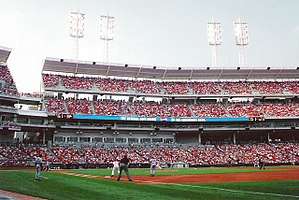
Riverfront Stadium, by then known as Cinergy Field, was demolished in 2002. Great American Ball Park opened in 2003 with high expectations for a team led by local favorites, including outfielder Ken Griffey, Jr., shortstop Barry Larkin, and first baseman Sean Casey. Although attendance improved considerably with the new ballpark, the team continued to lose. Schott had not invested much in the farm system since the early 1990s, leaving the team relatively thin on talent. After years of promises that the club was rebuilding toward the opening of the new ballpark, General Manager Jim Bowden and manager Bob Boone were fired on July 28. This broke up the father-son combo of manager Bob Boone and third baseman Aaron Boone, and Aaron was soon traded to the New York Yankees. Tragedy struck in November when Dernell Stenson, a promising young outfielder for the Reds, was shot and killed during a carjack. Following the season Dan O'Brien was hired as the Reds' 16th General Manager.
The 2004 and 2005 seasons continued the trend of big hitting, poor pitching, and poor records. Griffey, Jr. joined the 500 home run club in 2004,[15] but was again hampered by injuries. Adam Dunn emerged as consistent home run hitter, including a 535-foot (163 m) home run against José Lima. He also broke the major league record for strikeouts in 2004. Although a number of free agents were signed before 2005, the Reds were quickly in last place and manager Dave Miley was forced out in the 2005 mid season and replaced by Jerry Narron. Like many other small market clubs, the Reds dispatched some of their veteran players and began entrusting their future to a young nucleus that included Adam Dunn and Austin Kearns.
Late summer 2004 saw the opening of the Cincinnati Reds Hall of Fame (HOF). The Reds HOF had been in existence in name only since the 1950s, with player plaques, photos and other memorabilia scattered throughout their front offices. Ownership and management desired a stand-alone facility, where the public could walk through inter-active displays, see locker room recreations, watch videos of classic Reds moments and peruse historical items. The first floor houses a movie theater which resembles an older, ivy-covered brick wall ball yard. The hallways contain many vintage photographs. The rear of the building features a three-story wall containing a baseball for every hit Pete Rose had during his career. The third floor contains interactive exhibits including a pitcher's mound, radio booth, and children's area where the fundamentals of baseball are taught through videos featuring former Reds players.
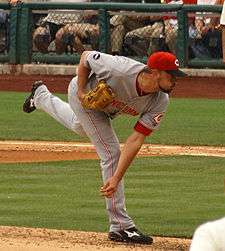
Robert Castellini took over as controlling owner from Lindner in 2006. Castellini promptly fired general manager Dan O'Brien and hired Wayne Krivsky. The Reds made a run at the playoffs but ultimately fell short. The 2007 season was again mired in mediocrity. Midway through the season Jerry Narron was fired as manager and replaced by Pete Mackanin. The Reds ended up posting a winning record under Mackanin, but finished the season in 5th place in the Central Division. Mackanin was manager in an interim capacity only, and the Reds, seeking a big name to fill the spot, ultimately brought in Dusty Baker. Early in the 2008 season, Krivsky was fired and replaced by Walt Jocketty. Though the Reds did not win under Krivsky, he is credited with revamping the farm system and signing young talent that could potentially lead the Reds to success in the future.
The Reds failed to post winning records in both 2008 and 2009. In 2010, with NL MVP Joey Votto and Gold Glovers Brandon Phillips and Scott Rolen the Reds posted a 91-71 record and were NL Central champions.[16] The following week, the Reds became only the second team in MLB history to be no-hit in a postseason game when Philadelphia's Roy Halladay shut down the National League's number one offense in game one of the NLDS.[17] The Reds lost in a 3-game sweep of the NLDS to Philadelphia.
After coming off their surprising 2010 NL Central Division Title, the Reds fell short of many expectations for the 2011 season. Multiple injuries and inconsistent starting pitching played a big role in their mid-season collapse, along with a less productive offense as compared to the previous year. The Reds ended the season at 79-83. The Reds won the 2012 NL Central Division Title. On September 28, Homer Bailey threw a 1-0 no-hitter against the Pittsburgh Pirates at PNC Park, this was the first Reds no-hitter since Tom Browning's perfect game in September of the 1988 season. Finishing with a 97–65 record, they earned the second seed in the Division Series and a match-up with the eventual World Series champion San Francisco Giants. After taking a 2–0 lead with road victories at AT&T Park, they headed home looking to win the series. However, they lost three straight at their home ballpark to become the first National League team since the Cubs in 1984 to lose a division series after leading 2–0.
In the off-season, the team traded outfielder Drew Stubbs, as part of a three team deal with the Arizona Diamondbacks and Cleveland Indians, to the Indians, and in turn received right fielder Shin-Soo Choo. On July 2, 2013, Homer Bailey pitched a no-hitter against the San Francisco Giants for a 4-0 Reds victory, making Bailey the third pitcher in Reds history with two complete game no-hitters in their career.
Following six consecutive losses to close out the 2013 season, including a loss to the Pittsburgh Pirates, at PNC Park, in the National League wild-card playoff game, the Reds decided to fire Dusty Baker. During his six years as manager, Baker led the Reds to the playoff three times; however, they never advanced beyond the first round.[18]
On October 22, 2013, the Reds hired pitching coach Bryan Price to replace Baker as manager.[19]
Under Bryan Price, the Reds were led by pitchers Johnny Cueto and the hard-throwing Cuban Aroldis Chapman. While the offense was led by all-star third baseman Todd Frazier, Joey Votto, and Brandon Phillips. Although with plenty of star power, the Reds never got off to a good start and ending the season in lowly fourth place in the division to go along with a 76-86 record. During the offseason, the Reds traded pitchers Alfredo Simón to the Tigers and Mat Latos to the Marlins. In return, they acquired young talents such as Eugenio Suárez and Anthony DeSclafani. They also acquired veteran slugger Marlon Byrd from the Phillies to play left field.
The Reds' 2015 season wasn't much better, as they finished with the second worst record in the league with a record of 64-98, their worst finish since 1982. The Reds were forced to trade star pitchers Johnny Cueto (to the Kansas City Royals) and Mike Leake (to the San Francisco Giants), receiving minor league pitching prospects for both. Shortly after the season's end, the Reds traded home run derby champion Todd Frazier to the Chicago White Sox, and closing pitcher Aroldis Chapman to the New York Yankees.
In 2016, the Reds broke the then record for home runs allowed during a single season, The Reds held this record until the 2019 season when it was broken by the Baltimore Orioles .The previous record holder was the 1996 Detroit Tigers with 241 longballs yielded to opposing teams.[20] The Reds went 68-94, and again were one of the worst teams in the MLB.[21] The Reds traded outfielder Jay Bruce to the Mets just before the July 31st non-waiver trade deadline in exchange for two prospects, infielder Dilson Herrera and pitcher Max Wotell.[22] During the offseason, the Reds traded Brandon Phillips to the Atlanta Braves in exchange for two minor league pitchers.[23]
Ballpark
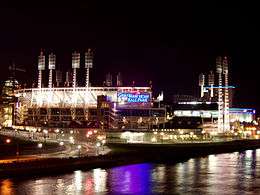
The Cincinnati Reds play their home games at Great American Ball Park, located at 100 Joe Nuxhall Way, in downtown Cincinnati. Great American Ball Park opened in 2003 at the cost of $290 million and has a capacity of 42,271. Along with serving as the home field for the Reds, the stadium also holds the Cincinnati Reds Hall of Fame. The Hall of Fame was added as a part of Reds tradition allowing fans to walk through the history of the franchise as well as participating in many interactive baseball features.[24]
Great American Ball Park is the seventh home of the Cincinnati Reds, built immediately to the north of the site on which Riverfront Stadium, later named Cinergy Field, once stood. The first ballpark the Reds occupied was Bank Street Grounds from 1882 to 1883 until they moved to League Park I in 1884, where they would remain until 1893. Through the late 1890s and early 1900s (decade), the Reds moved to two different parks where they stayed for less than ten years. League Park II was the third home field for the Reds from 1894 to 1901, and then moved to the Palace of the Fans which served as the home of the Reds in the 1910s. It was in 1912 that the Reds moved to Crosley Field which they called home for 58 years. Crosley served as the home field for the Reds for two World Series titles and five National League pennants. Beginning June 30, 1970, and during the dynasty of the Big Red Machine, the Reds played in Riverfront Stadium, appropriately named due to its location right by the Ohio River. Riverfront saw three World Series titles and five National League pennants. It was in the late 1990s that the city agreed to build two separate stadiums on the riverfront for the Reds and the Cincinnati Bengals. Thus, in 2003, the Reds began a new era with the opening of the current stadium.
The Reds hold their spring training in Goodyear, Arizona at Goodyear Ballpark. The Reds moved into this stadium and the Cactus League in 2010 after staying in the Grapefruit League for most of their history. The Reds share Goodyear Park with their rivals in Ohio, the Cleveland Indians.
Logos and uniforms
Logo
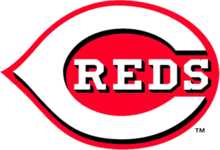
Throughout the history of the Cincinnati Reds, many different variations of the classic wishbone "C" logo have been introduced. For most of the history of the Reds, especially during the early history, the Reds logo has been simply the wishbone "C" with the word "REDS" inside, the only colors used being red and white. However, during the 1950s, during the renaming and re-branding of the team as the Cincinnati Redlegs because of the connections to communism of the word 'Reds', the color blue was introduced as part of the Reds color combination.[25] During the 1960s and 1970s the Reds saw a move towards the more traditional colors, abandoning the navy blue. A new logo also appeared with the new era of baseball in 1972, when the team went away from the script "REDS" inside of the "C", instead, putting their mascot Mr. Redlegs in its place as well as putting the name of the team inside of the wishbone "C". In the 1990s the more traditional, early logos of Reds came back with the current logo reflecting more of what the team's logo was when they were first founded.
Uniform
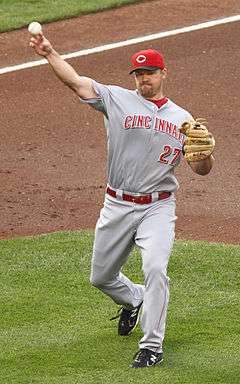
Along with the logo, the Reds' uniforms have been changed many different times throughout their history. Following their departure from being called the "Redlegs" in 1956 the Reds made a groundbreaking change to their uniforms with the use of sleeveless jerseys, seen only once before in the Major Leagues by the Chicago Cubs. At home and away, the cap was all-red with a white wishbone C insignia. The long-sleeved undershirts were red. The uniform was plain white with a red wishbone C logo on the left and the uniform number on the right. On the road the wishbone C was replaced by the mustachioed "Mr. Red" logo, the pillbox-hat-wearing man with a baseball for a head. The home stockings were red with six white stripes. The away stockings had only three white stripes.
The Reds changed uniforms again in 1961, when they replaced the traditional wishbone C insignia with an oval C logo, but continued to use the sleeveless jerseys. At home, the Reds wore white caps with the red bill with the oval C in red, white sleeveless jerseys with red pinstripes, with the oval C-REDS logo in black with red lettering on the left breast and the number in red on the right. The gray away uniform included a gray cap with the red oval C and a red bill. Their gray away uniforms, which also included a sleeveless jersey, bore CINCINNATI in an arched block style across with the number below on the left. In 1964, players' last names were placed on the back of each set of uniforms, below the numbers. Those uniforms were scrapped after the 1966 season.
However, the Cincinnati uniform design most familiar to baseball enthusiasts is the one whose basic form, with minor variations, held sway for the 26 seasons from 1967 to 1992. Most significantly, the point was restored to the C insignia, making it a wishbone again. During this era, the Reds wore all-red caps both at home and on the road. The caps bore the simple wishbone C insignia in white. The uniforms were standard short-sleeved jerseys and standard trousers—white at home and grey on the road. The home uniform featured the Wishbone C-REDS logo in red with white type on the left breast and the uniform number in red on the right. The away uniform bore CINCINNATI in an arched block style across the front with the uniform number below on the left. Red, long-sleeved undershirts and plain red stirrups over white sanitary stockings completed the basic design. The Reds wore pinstriped home uniforms in 1967 only, and the uniforms were flannel through 1971, changing to double-knits with pullover jerseys and beltless pants in 1972. Those uniforms lasted 21 seasons, and the 1992 Reds were the last MLB team to date whose primary uniforms featured pullover jerseys and beltless pants.
The 1993 uniforms (which did away with the pullovers and brought back button-down jerseys) kept white and gray as the base colors for the home and away uniforms, but added red pinstripes. The home jerseys were sleeveless, showing more of the red undershirts. The color scheme of the C-REDS logo on the home uniform was reversed, now red lettering on a white background. A new home cap was created that had a red bill and a white crown with red pinstripes and a red wishbone C insignia. The away uniform kept the all-red cap, but moved the uniform number to the left, to more closely match the home uniform. The only additional change to these uniforms was the introduction of black as a primary color of the Reds in 1999, especially on their road uniforms.
The Reds latest uniform change came in December 2006 which differed significantly from the uniforms worn during the previous eight seasons. The home caps returned to an all-red design with a white wishbone C, lightly outlined in black. Caps with red crowns and a black bill became the new road caps. Additionally, the sleeveless jersey was abandoned for a more traditional design. The numbers and lettering for the names on the backs of the jerseys were changed to an early-1900s style typeface, and a handlebar mustached "Mr. Redlegs" – reminiscent of the logo used by the Reds in the 1950s and 1960s – was placed on the left sleeve.[26]
Awards and accolades
Team captains
- Jake Daubert 1919–1924
- 14 Pete Rose 1970–1978
- 13 Dave Concepción 1983–1988
- 11 Barry Larkin 1997–2004
Retired numbers
The Cincinnati Reds have retired ten numbers in franchise history, as well as honoring Jackie Robinson, whose number is retired league-wide around Major League Baseball.
All of the retired numbers are located at Great American Ball Park behind home-plate on the outside of the press box. Along with the retired player and manager number, the following broadcasters are honored with microphones by the broadcast booth: Marty Brennaman, Waite Hoyt, and Joe Nuxhall.[27]
|
On April 15, 1997, #42 was retired throughout Major League Baseball in honor of Jackie Robinson.
Baseball Hall of Famers
| Cincinnati Reds Hall of Famers |
|---|
| Affiliation according to the National Baseball Hall of Fame and Museum |
|
Ford C. Frick Award recipients
| Cincinnati Reds Ford C. Frick Award recipients | |||||||||
|---|---|---|---|---|---|---|---|---|---|
| Affiliation according to the National Baseball Hall of Fame and Museum | |||||||||
|
MLB All-Star Games
The Reds have hosted the Major League Baseball All-Star Game five times: twice at Crosley Field (1938, 1953), twice at Riverfront Stadium (1970, 1988), and once at Great American Ball Park (2015). (Until 2019, the Reds shared this record with the Cleveland Indians and the Pittsburgh Pirates; Cleveland broke this tie in 2019, hosting the All-Star Game for the sixth time.)
Ohio Cup
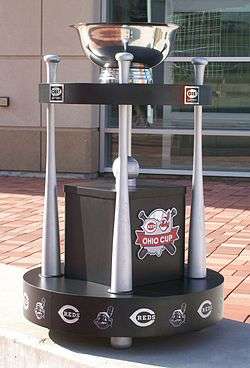
The Ohio Cup was an annual pre-season baseball game, which pitted the Ohio rivals Cleveland Indians and Cincinnati Reds. In its first series it was a single-game cup, played each year at minor-league Cooper Stadium in Columbus, was staged just days before the start of each new Major League Baseball season.
A total of eight Ohio Cup games were played, in 1989 to 1996, with the Indians winning six of them. The winner of the game each year was awarded the Ohio Cup in postgame ceremonies. The Ohio Cup was a favorite among baseball fans in Columbus, with attendances regularly topping 15,000.
The Ohio Cup games ended with the introduction of regular-season interleague play in 1997. Thereafter, the two teams competed annually in the regular-season Battle of Ohio or Buckeye Series. The Ohio Cup was revived in 2008 as a reward for the team with the better overall record in the Reds-Indians series each year.
Media
Radio
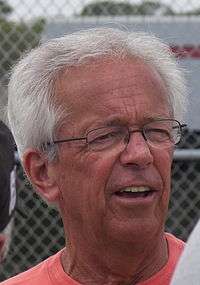
The Reds' flagship radio station has been WLW, 700AM since 1969. Prior to that, the Reds were heard over: WKRC, WCPO, WSAI and WCKY. WLW, a 50,000-watt station, is "clear channel" in more than one way, as iHeartMedia owns the "blowtorch" outlet which is also known as "The Nation's Station".
Marty Brennaman has been the Reds' play-by-play voice since 1974 and has won the Ford C. Frick Award for his work, which includes his famous call of "... and this one belongs to the Reds!" after a win. Joining him for years on color was former Reds pitcher Joe Nuxhall, who worked in the radio booth from 1967 (the year after his retirement as an active player) until 2004, plus three more seasons doing select home games until his death, in 2007.
In 2007, Thom Brennaman, a veteran announcer seen nationwide on Fox Sports, joined his father Marty in the radio booth. Retired relief pitcher Jeff Brantley, formerly of ESPN, also joined the network in 2007. As of 2010, Brantley and Thom Brennaman's increased TV schedule (see below) has led to more appearances for Jim Kelch, who had filled in on the network since 2008. In 2019, the Reds hired then-Pensacola Blue Wahoos radio play-by-play announcer Tommy Thrall to provide in-game and post-game coverage as well as a fill in play-by-play announcer.[28]
Television
Televised games are seen exclusively on Fox Sports Ohio and Fox Sports Indiana. In addition, Fox Sports South televises Fox Sports Ohio broadcasts of Reds games to Tennessee and western North Carolina. George Grande, who hosted the first SportsCenter on ESPN in 1979, was the play-by-play announcer, usually alongside Chris Welsh, from 1993 until his retirement during the final game of the 2009 season. Since 2009, Grande has worked part-time for the Reds as play-by-play announcer in September when Thom Brennaman is covering the NFL for Fox Sports. He has also made guest appearances throughout the season. Brennaman has been the head play-by-play commentator since 2010, with Welsh and Brantley sharing time as the color commentators. Paul Keels, who left in 2011 to become the play-by-play announcer for the Ohio State Buckeyes Radio Network, was the Reds' backup play-by-play television announcer during the 2010 season. Jim Kelch served as Keels' replacement. The Reds also added former Cincinnati First Baseman Sean Casey – known as "The Mayor" by Reds fans – to do color commentary for approximately 15 games in 2011.[29]
NBC affiliate WLWT carried Reds games from 1948 to 1995. Among those that have called games for WLWT include Waite Hoyt, Ray Lane, Steve Physioc, Johnny Bench, Joe Morgan, and Ken Wilson. Al Michaels, who established a long career with ABC and NBC, spent three years in Cincinnati early in his career. The last regularly-scheduled, over-the-air broadcasts of Reds games were on WSTR-TV from 1996 to 1998. Since 2010, WKRC-TV has simulcast Opening Day games with Fox Sports Ohio.
Roster
Cincinnati Reds roster | ||||||
|---|---|---|---|---|---|---|
| Active roster | Player pool | Coaches/Other | ||||
|
Pitchers
Bullpen
Closer |
Catchers
Infielders
Outfielders |
Pitchers
Catchers
Infielders
Outfielders
|
Manager
Coaches
45-day injured list
28 active, 31 player pool
| |||
Minor league affiliations
The Cincinnati Reds farm system consists of eight minor league affiliates.[30]
| Level | Team | League | Location | Ballpark |
|---|---|---|---|---|
| Triple-A | Louisville Bats | International League | Louisville, Kentucky | Louisville Slugger Field |
| Double-A | Chattanooga Lookouts | Southern League | Chattanooga, Tennessee | AT&T Field |
| Class A-Advanced | Daytona Tortugas | Florida State League | Daytona Beach, Florida | Jackie Robinson Ballpark |
| Class A | Dayton Dragons | Midwest League | Dayton, Ohio | Day Air Ballpark |
| Rookie | Billings Mustangs | Pioneer League | Billings, Montana | Dehler Park |
| Greeneville Reds | Appalachian League | Greeneville, Tennessee | Pioneer Park | |
| AZL Reds | Arizona League | Goodyear, Arizona | Goodyear Ballpark | |
| DSL Reds | Dominican Summer League | Boca Chica, Santo Domingo | Baseball City Complex |
References
- Footer, Alyson (August 6, 2014). "Reds pay homage to past with 2015 All-Star logo". Reds.com. MLB Advanced Media. Archived from the original on April 21, 2018. Retrieved April 21, 2018.
The primary logo in the center of the illustration depicts the handlebar mustache and old-style square cap worn by the Reds' most traditional mascot, Mr. Redlegs. His perfectly round head sits on top of the Reds' classic oval-shaped "C." The crossed bats represent a traditional baseball design, while the addition of deep red creates dimension to the Reds' colors of red and black.
- "History of Reds Logos". Reds.com. MLB Advanced Media. Archived from the original on January 14, 2019. Retrieved January 13, 2019.
- "Reds Timeline". Cincinnati Reds. August 26, 2015. Archived from the original on September 5, 2015. Retrieved August 26, 2015.
- "Cincinnati Reds Team History & Encyclopedia". Baseball Reference. Baseball Info Solutions. Archived from the original on 2011-04-06. Retrieved 2019-02-27.
- DeGange, John (16 April 1953). "Ins and Outs". The Day (New London, Connecticut). p. 10. Retrieved 27 May 2015.
- "Sports People; Fingers Won't Conform". The New York Times. February 22, 1986. Archived from the original on October 24, 2012. Retrieved April 30, 2010.
- Rogers, Thomas (February 28, 1986). "SCOUTING; Times Change, But Reds Don't". New York Times. Archived from the original on April 21, 2018. Retrieved April 21, 2018.
For years, the Reds were the only team that permitted no color other than the standard black on their uniform shoes. But last year they allowed the players to paint red stripes on the shoes, and this year they're going to all-red models. The shoes are all supposed to match our red stockings, says a cautious Mrs. Schott. I just hope they don't come out shocking pink.
- Taylor, Kelly. "Big Red Machine's "Great Eight" to reunite at GABP". FOX 19. FOX19-WXIX. Archived from the original on 21 May 2014. Retrieved 6 September 2013.
- Pahigian, Joshua; Kevin O'Connell (2004). The Ultimate Baseball Road-Trip: A Fan's Guide to Major League Stadiums. Guilford, Conn: Lyons Press. p. 208. ISBN 1592281591.
- "1976 Cincinnati Reds Statistics and Roster". Baseball-Reference.com. Archived from the original on 2008-03-24. Retrieved 2008-03-30.
- "1981 Cincinnati Reds Statistics and Roster". Baseball-Reference.com. Archived from the original on 2008-04-11. Retrieved 2008-03-30.
- "1982 Cincinnati Reds Schedule, Box Scores and Splits". Baseball-Reference.com. Archived from the original on 2008-04-04. Retrieved 2008-03-30.
- "BASEBALL; Call for Schott to Step Down". New York Times. December 7, 1992. Retrieved 2008-03-30.
- "Poor Communication at Heart of Feud". The Washington Post. May 12, 1998. Archived from the original on June 1, 2010. Retrieved April 30, 2010.
- "Ken Griffey Career Home Runs". Baseball-Reference.com. Archived from the original on February 18, 2017. Retrieved January 25, 2017.
- "Reds are NL Central Champs! | Cincinnati Reds". Cincinnati.com. 2010-09-28. Archived from the original on 2012-10-05. Retrieved 2012-06-19.
- "MLB.com At Bat | MLB.com: Gameday". Mlb.mlb.com. 2010-10-06. Archived from the original on 2013-05-23. Retrieved 2012-06-19.
- "Reds dismiss manager Dusty Baker". ESPN.com. October 4, 2013. Archived from the original on October 7, 2013. Retrieved March 11, 2014.
- "Reds set to promote Price to manager". Archived from the original on 2017-08-21. Retrieved 2017-12-19.
- "The Reds just set a record that sums up just how bad they have been this year". Archived from the original on 2016-10-02. Retrieved 2016-09-27.
- "Regular Season Standings". Major League Baseball. Archived from the original on 2017-01-06. Retrieved 2017-01-06.
- "Cincinnati Reds 2016 Team Transactions: Trades, DL, Free Agents and Callups - ESPN". ESPN.com. Archived from the original on 2017-01-06. Retrieved 2017-01-06.
- "Braves, Reds close deal for Brandon Phillips". MLB.com. Archived from the original on 2017-12-22. Retrieved 2017-12-19.
- "Hall of Fame & Museum | reds.com: Ballpark". Mlb.mlb.com. 2010-07-18. Archived from the original on 2012-11-06. Retrieved 2012-06-19.
- Yglesias, Matthew. "Communist Bo Xilai gets ousted: Why do communists like red so much?". Slate Magazine. Archived from the original on 2012-06-18. Retrieved 2012-06-19.
- Sheldon, Mark (December 1, 2006). "Reds unveil new-look uniforms". Major League Baseball Advanced Media. Archived from the original on January 3, 2017. Retrieved January 2, 2017.
- See List of Major League Baseball retired numbers#Similar honors.
- Tommy Thrall Reflects On Wahoos Career After Call-Up
- "FOX Sports Ohio announces 2011 Reds broadcast team | reds.com: Official Info". Cincinnati.reds.mlb.com. 2011-01-14. Archived from the original on 2011-01-18. Retrieved 2012-06-19.
- "Cincinnati Reds Minor League Affiliates". Baseball-Reference. Sports Reference. Retrieved May 15, 2020.
External links
| Wikimedia Commons has media related to Cincinnati Reds. |
- Cincinnati Reds official website
- Reds Minor Leagues News
- SCSR / 19th Century Cincinnati Base Ball
- Voices of Oklahoma interview with Johnny Bench. First person interview conducted on March 28, 2012 with Johnny Bench, Hall of Fame Catcher for the Cincinnati Reds.
